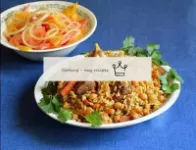Pilaf
Pilaf is a dish of oriental cuisine. The word "pilov" came to the Russian language from the Turkic-Tatar languages, where it sounds like "pilav." The origin of pilaf is associated with India and Persia, from where it spread throughout Asia. More details about pilaf...
Pilaf, the recipe for the preparation of which provides for the joint preparation of zirvak and cereals, is called Central Asian or Uzbek. The only exception is the Samarkand pilaf, which is being prepared using Azerbaijani technology. Various recipes for pilaf arise from the choice and combination of zirvak, grains, vegetables, spices, bookmark sequence and duration of food processing stipulated by the pilaf recipe. As you know, in Asia, they usually prepare lamb pilaf. Rice for cooking pilaf according to Central Asian technology should be special - this is red Uzgen rice or "devzira. " Only yellow carrots are considered an obligatory vegetable. Of the spices, zira, red pepper, barberry, garlic, as well as dried apricots, quince and raisins are usually used. For the Uzbek pilaf, preliminary calcination of oil is very important. Traditionally, a mixture of vegetable (more often cotton, less often sunflower, sesame) oil and animal fat (lamb, goat) is used. Uzbek pilaf is prepared exclusively in a large thick-walled cast-iron, aluminum or copper cauldron, on an open fire and outdoors, because even a very good extract is difficult to cope with the consequences of burning oil.
In the Azerbaijani (Iranian or Turkish) version of pilaf refueling, "gara, " and cereals are prepared separately and combined only on a common dish or even on a plate. Gara can be meat, fish, egg, vegetable. Almost all recipes of Azerbaijani pilaf use fruits - cherry plum, pomegranate, apricot, etc. For example, pilaf from chicken in Persian is prepared exclusively with pomegranate juice. Pilaf rice is always boiled with butter - creamy or melted. Unlike the Uzbek pilaf, the Azerbaijani pilaf is served not hot, but a little warm, but with not yet frozen oil.
Here you should recall the Turkish saying "How many Muslim cities exist in the world, so many recipes for pilaf exist in the world, " and make a reservation that in different countries you can find a lot of variations that combine both methods of cooking pilaf. At the same time, today the most common version of pilaf is still the Uzbek pilaf. Combining rice and meat with vegetables and spices in Kazan, they prepare pilaf from pork (which, in principle, is impossible in Muslim countries), pilaf with chicken, pilaf from beef - products that are not popular in Central Asia. The original taste is Indian sweet pilaf with dried fruits. In general, choose a pilaf recipe, prepare this wonderful dish and let it taste good for you!
How to cook pilaf. Our tips
Pilaf rice. Do not use Indian or Thai varieties of rice - basmati or jasmine. They are too soft, boil quickly and turn into porridge. If you don't find a devzira or oshpara, take Italian rice for paella.
Oil for pilaf. Use only refined oil, the aromatic oil will drown out the smell of pilaf.
Pilaf spices. Only cumin, hot red pepper and barberry are mandatory. Everything else is for your taste.
 Español
Español Français
Français Português
Português Русский
Русский 简体中文
简体中文 繁體中文
繁體中文 日本語
日本語 한국어
한국어 العربية
العربية Türkçe
Türkçe Қазақ
Қазақ Deutsch
Deutsch Italiano
Italiano Українська
Українська









